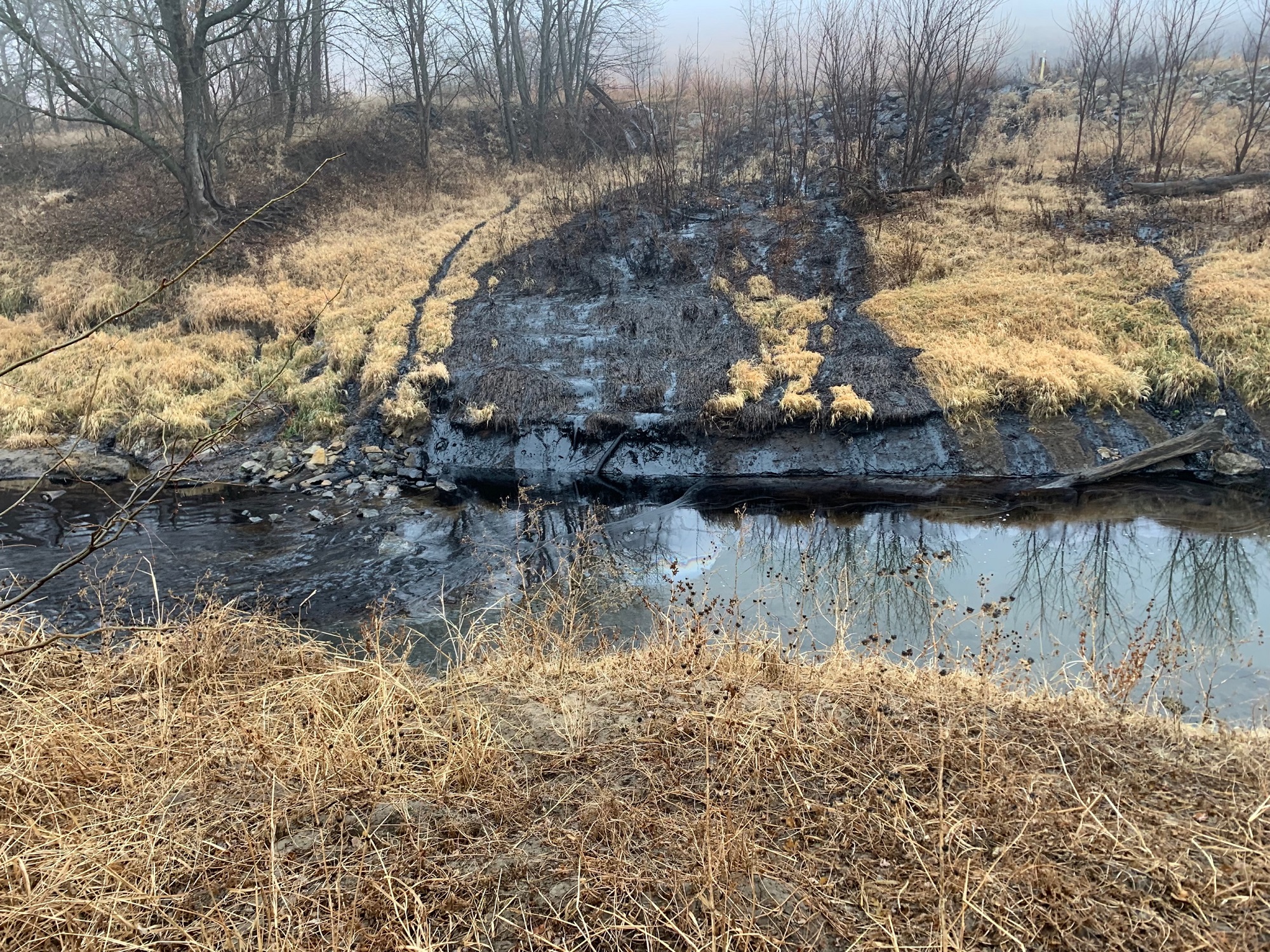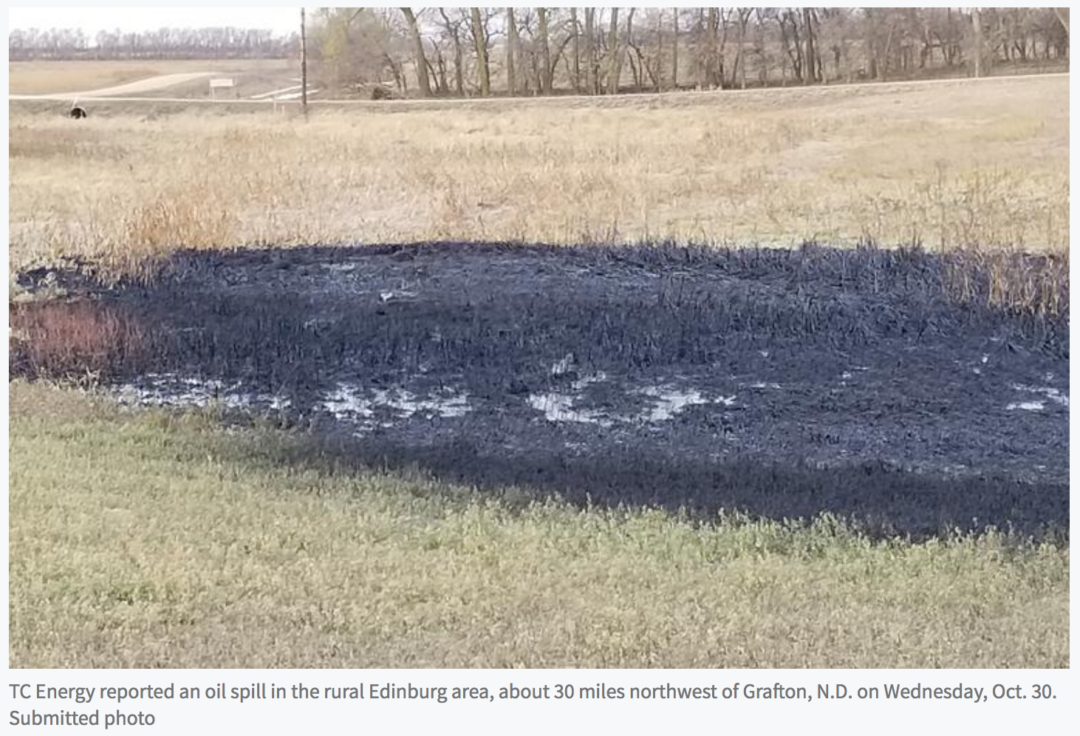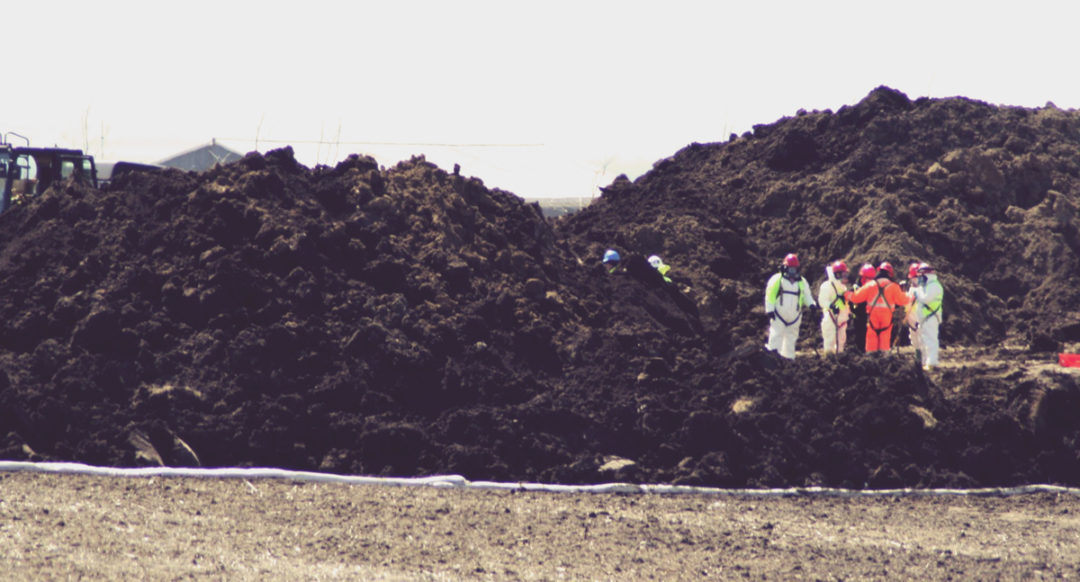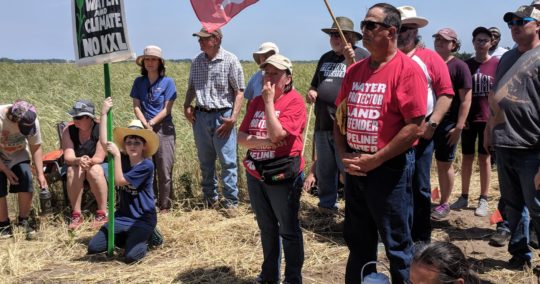





HISTORY OF SPILLS: TC Energy’s Keystone pipeline (22 SPILLS: 2010-2022)
(Note: TC Energy’s (formerly TransCanada) “Keystone pipeline” is not to be confused with the company’s proposed “Keystone XL” pipeline — a separate pipeline project that was defeated and cancelled two separate times under Pres. Obama and Pres. Biden. The Keystone 1 pipeline carries up to 720,000 barrels per day of tarsands from Alberta, Canada to refineries in Texas and Illinois.)
U.S. EPA Interactive Website: TC Energy Mill Creek Oil Spill Emergency Response
- December 8, 2022: PHMSA issues Corrective Action Order to TC Energy re: Dec. 7 spill.
- #22: Dec. 7, 2022: TC Energy shut down its Keystone pipeline after detecting a leak of 588,000 gallons into a creek near Washington, KS — about 20 miles south of Steele City, NE. “An emergency shutdown and response was initiated at about 9 p.m. CT on Dec. 7 after alarms and a pressure drop in the system, the company said in a release, adding booms were deployed to control downstream migration of the release.”
- November 5, 2019: PHMSA issues Corrective Action Order to TransCanada re: Oct. 30 spill.
- #21: October 31, 2019: TransCanada’s (“TC Energy”) Keystone pipeline leaked at least 380,000 gallons of tarsands oil and toxic diluents that affected wetlands in northeastern North Dakota. No cause has yet been established.
- #20: February 6, 2019: Keystone pipeline spills 1,800 gallons in St. Charles County, Missouri. After metallurgical analysis of the spill’s cause: “The composite wrap was inadequately designed for the metal loss feature it was to protect, as the applicator’s interpretation of the feature as mechanical damage led to fewer wraps than corrosion given the naming convention used in the composite vendor’s software. Feature direct examination concluded blunt metal loss with no evidence of sharp edges or stress concentrators, and the feature root cause analysis determined the accelerated rate of corrosion was primarily caused by stray direct current interference and was subsequently repaired. The RCFA indicated the primary cause of the leak was a through-wall crack that exhibited signs of fatigue, initiated from localized stress concentrations in the irregular pitted surface of the repaired metal loss feature.” Of note: A 2015 investigation in the same county found Keystone pipe there had “suffered from corrosion so severe that it was worn through 95 percent in some places after being in service for less than two years. In one spot, inspectors found the pipeline was down to a metal layer just one third the thickness of a dime.”
- #19: February 20, 2018: Keystone pipeline spills 15 gallons from a Pump Station in Steele City, Nebraska, blamed on “a leaking float control valve.”
- November 28, 2017: PHMSA issues Corrective Action Order to TransCanada re: Nov. 17 spill.
- #18: November 16, 2017: Keystone pipeline leaks 407,000 gallons on farmland near Amherst, South Dakota. Spill was originally underreported as 210,000 gallons, and was attributed to “the installation of a weight upon its construction in 2008” that is “used to keep pipelines in place and reduce the risk of damage to the line if water levels rise,” but instead “caused mechanical damage to the company’s corrosion-resistant coating, leading to the rupture.”
- #17: December 27, 2016: Keystone pipeline spilled 10 gallons at a Pump Station near Tina, Missouri.
- May 2016: TransCanada announces plans to “dig up and replace sections of its Keystone pipeline found to not meet federal strength standards.”
- April 9, 2016: PHMSA issues Corrective Action Order to TransCanada re: the April 2 spill.
- #16: April 2, 2016: Keystone pipeline leaks 16,800 gallons in Hutchinson County, South Dakota, cause found to be a “faulty girth weld,” the point of a transition weld connecting smaller and larger pipe together. TransCanada whistleblower and former company engineer Evan Vokes has repeatedly sounded the alarm about TransCanada’s use of transition welds.
- April 2015: A Freedom of Information Act (FOIA) request made to PHMSA in 2013 returns documents uncovering an alarming rate of corrosion on TransCanada’s Keystone pipeline: “a section of the pipeline’s wall had corroded 95%, leaving it paper-thin in one area (one-third the thickness of a dime) and dangerously thin in three other places.” PHMSA did not disclose a cause for the corrosion at the time, saying it “might impact an ongoing compliance review the agency is conducting of TransCanada.”
- #15: July 24, 2014: Keystone pipeline leaks 30 gallons in Nederland, Texas.
- #14: March 7, 2013: Keystone pipeline leaks 15 gallons near Potwin, Kansas.
- June 28, 2011: PHMSA issues Corrective Action Order to TransCanada re: May 7 & May 29 leaks.
- #13: May 29, 2011: Keystone pipeline leaks 14,000 gallons after “valve failure” at Severance Pump Station in southeastern North Dakota, which saw “a 1/2-inch diameter nipple at the pressure transmitter manifold. Preliminary metallurgical testing provided by the Respondent of this nipple indicates cyclical fatigue.”
- #12 May 25, 2011: Keystone pipeline leaks unknown volume at Roswell Pump Station due to a “transmitter fitting leak” that “failed due to cyclical fatigue.” (This spill is only reported in the context of a separate Corrective Action Order related to the May 7th 16,800-gallon Keystone spill where the same cause “cyclical fatigue” was reported.)
- #11: May 7, 2011: Keystone pipeline leaks 16,800 gallons (400 barrels) at Ludden Pump Station onto private land in North Dakota. The spill spewed up 60 feet in the air “like a geyser” and was discovered by local rancher smelling it on his land; he’s still dealing with TransCanada over cleanup. The spill was caused by “a threaded connection on small diameter station piping at a 1-inch x 3/4-inch swaged nipple. Respondent performed metallurgical analysis of the nipple and identified the presence of cracks at the root of the thread likely as a result of over-torque during installation. Respondent determined that the cyclic bending stress fatigue due to normal operational vibration propagated the cracks to failure.”
- #10: March 16, 2011: Keystone pipeline leaks 126 gallons at Seneca Pump Station in Nemaha County, Kansas, after “a seal on the #4 unit failed releasing crude oil onto the piping, the pump and the ground.”
- #9: March 8, 2011: Keystone pipeline leaks 5 gallons from Ludden Pump Station near Brampton, North Dakota “due to equipment failure on a seal on a main pump.”
- #8: February 23, 2011: Keystone pipeline leaks 10 gallons from Rock Pump Station near Udall, Kansas “on a drain valve line possibly due to a leaky fitting.”
- #7: February 3, 2011: Keystone pipeline leaks 15 gallons “from a vapor separator which caused an overflow” at a Pump Station near Cushing, Oklahoma.
- #6: January 31, 2011: Keystone pipeline leaks 10 gallons at a Pump Station near Turney, Missouri after a “seal on a pump failed.”
- #5: January 5, 2011: Keystone pipeline leaks 10 gallons at a Pump Station near Andover, South Dakota. Spill blamed on “faulty seal.”
- #4: August 19, 2010: Keystone pipeline leaks 10 gallons near Hartington, Nebraska after “a check valve on a pressure transmitter located on the suction side of a line pump stuck open.”
- #3: August 10, 2010: Keystone pipeline leaks 5 gallons near Freeman, South Dakota, “cause unknown.”
- #2: June 23, 2010: Keystone pipeline leaks 20 gallons at Roswell Pump Station in North Dakota blamed on “equipment failure.”
- #1: May 21, 2010: Keystone pipeline leaks 2 gallons at Carpenter Pump Station in Clark County, South Dakota. Spill is blamed on a “leaking valve body.”
This interactive map compiled by Greenpeace USA / Tim Donaghy shows the locations and relative size of all 21 spills on TransCanada’s Keystone pipeline:
Canada’s Transportation Safety Board also noted 21 leak incidents on TransCanada’s Keystone pipeline system in its first year of operation — which would also include spills on the Canadian portion of the pipeline not documented by U.S. regulators — so the U.S. total of 21 total spills is likely even larger for the full length of the pipeline.
On Oct. 31, Governor Doug Burgum of oil industry-friendly North Dakota “appealed to Keystone pipeline owner TC Energy to review its inspection and monitoring of the line after it leaked an estimated 383,000 gallons in the northeastern part of the state.” Meanwhile on the federal level, Sen. Ed Markey (D-Mass.) sent a letter to TransCanada on Nov. 1 demanding answers about the spill, and “expresses concerns that TC Energy appears to be acting negligently in allowing these repeated spills to occur, and in failing to prevent further spills.”
“These recurring pipeline incidents call into question whether TC Energy should continue to operate this pipeline if it cannot do so safely,” writes Senator Markey in his letter to TC Energy President and CEO Russel Girling. “They further call into question President Trump’s March 2019 decision to promote the pipeline’s expansion by granting permission for the construction of Keystone XL. That decision flies in the face of the climate crisis and — as is becoming increasingly clear — public safety and acceptable operating practices.”
In his letter, Senator Markey requests answers to questions that include:
- Is the reported 383,000 gallons an accurate assessment of the oil spilled in the most recent leak?
- What methodology is TC Energy using to calculate the rate and volume of oil spilled?
- Has TC Energy made changes to its methodology that underestimated leak volumes in 2016 and 2017?
- How often does TC Energy inspect the Keystone pipeline for cracks and leaks, and what technology does it use to do so?
- What was the probable cause of this week’s oil leak near Edinburg, North Dakota?
TransCanada stated to the public and state and federal agencies and elected officials before the Keystone pipeline started construction in 2010 in a risk assessment prepared by ENSR / AECOM that it estimated it would spill eleven (11) times over the course of its expected lifetime (approx. 50-100 years):
- “Of the postulated 1.4 spills along the Keystone Pipeline system during a 10-year period, the study’s findings suggest that approximately 0.2 would be 50 barrels or less; 0.8 would consist of 50 to 1000 barrels; 0.3 would consist of between 1,000 and 10,000 barrels; and 0.2 would contain more than 10,000 barrels … Based on probabilities generated from the study, the estimated occurrence intervals for a spill of 50 barrels or less occurring anywhere along the entire pipeline system is once every 65 years, a spill between 50 and 1,000 barrels might occur once in 12 years; a spill of 1,000 and 10,000 barrels might occur once in 39 years; and a spill containing more than 10,000 barrels might occur once in 50 years.” — ENSR / AECOM Report: “Pipeline Risk Assessment and Environmental Consequence Analysis“
Dr. John Stansbury of the University of Nebraska at Lincoln also conducted an independent analysis that provides more detail on the potential risks for the Ogallala Aquifer than the analysis offered by TransCanada.
In his analysis of potential risks of spills on the Keystone pipeline, Dr. Stansbury of UNL concluded that safety assessments provided by TransCanada are misleading. According to Dr. Stansbury, “We can expect no fewer than 2 major spills per state during the 50-year projected lifetime of the pipeline. These spills could release as much as 180 thousand barrels of oil each.” More of Dr. Stansbury’s conclusions:
- “While TransCanada estimates that the Keystone XL will have 11 significant spills (more than 50 barrels of crude oil) over 50 years, a more realistic assessment is 91 significant spills over the pipeline’s operational lifetime. TransCanada arbitrarily and improperly adjusted spill factors to produce an estimate of one major spill on the 1,673 mi (2,692 km) of pipeline about every five years, but federal data on the actual incidence of spills on comparable pipelines indicate a more likely average of almost two major spills per year. (The existing Keystone I pipeline has had one major spill and 11 smaller spills in its first year of operation.)”
- “Analysis of the time needed to shut down the pipeline shows that response to a leak at a river crossing could conservatively take more than ten times longer than the 11 minutes and 30 seconds that TransCanada assumes. (After the June 2010 spill of more than 800,000 US gallons (3,000,000 L) of crude oil into a tributary of the Kalamazoo River, an Enbridge tar sands pipeline – a 30-inch (760 mm) pipe compared to the 36-inch (910 mm) Keystone XL – was not completely shut down for 12 hours.)”
- “Realistic calculations yield worst-case spill estimates of more than 180,000 barrels (7,600,000 US gal; 29,000,000 L) in the Nebraska Sandhills above the Ogallala Aquifer, more than 160,000 barrels (6,700,000 US gal; 25,000,000 L) of crude oil at the Yellowstone River crossings, more than 140,000 barrels (5,900,000 US gal; 22,000,000 L) at the Platte River crossing and more than 120,000 barrels (5,000,000 US gal; 19,000,000 L) at the Missouri River crossing.”
- “Contaminants from a release at the Missouri or Yellowstone River crossing would enter Lake Sakakawea in North Dakota where they would adversely affect drinking water intakes, aquatic wildlife, and recreation. Contaminants from a spill at the Platte River crossing would travel downstream unabated into the Missouri River for several hundred miles affecting drinking water intakes for hundreds of thousands of people (e.g., Lincoln, NE; Omaha, NE; Nebraska City, NE; St. Joseph, MO; Kansas City, MO) as well as aquatic habitats and recreational activities. In addition, other constituents from the spill would pose serious risks to humans and to aquatic species in the river.”
- “The worst-case site for such a spill is in the Sandhills region of Nebraska. The Sandhills are ancient sand dunes that have been stabilized by grasses. Because of their very permeable geology, nearly 100 percent of the annual rainfall infiltrates to a very shallow aquifer, often less than 20 feet below the surface. This aquifer is the well-known Ogallala Aquifer that is one of the most productive and important aquifers in the world.”



